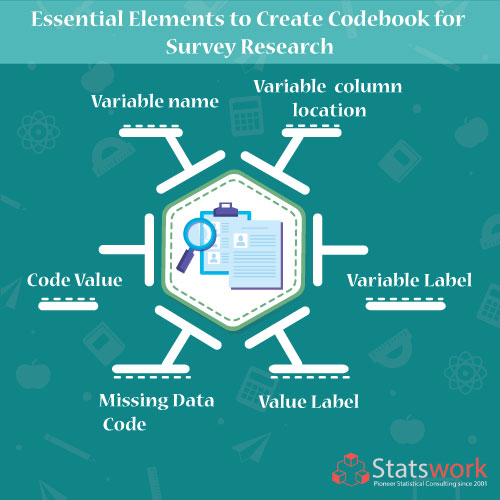How to create a codebook for Survey Research?
In-Brief
- At the initial level, a Codebook for Survey Research explains the data’s layouts in the data file and explains the data codes what they mean.
- Codebook needs a complete list of data, which contains each variable’s name, the values the variables takes and a complete explanation of how it is operationalized.
Introduction
Survey researchers use codebooks for two main purposes: To offer a guide for coding and serve as documentation of a data file’s layout and code descriptions. Data files generally comprise one line for each observation, such as a respondent or records. Every column represents a single variable; nevertheless, one variable may span various columns. At the initial level, a codebook explains the data’s layouts in the data file and explains the data codes what they mean. They are used to document the values (answers) related to the survey question. Every answer category is assigned with a unique numeric value, and the researcher then uses these unique numeric values.
Survey research and Quantitative analysis method for which a researcher poses the same set of questions, typically in a written format, to a sample of individuals. It is a quantitative method whereby a researcher poses predetermined questions to an entire group, or sample, of individuals.
Step involved in preparing a codebook –
It needs a complete list of data, which contains each variable’s name, the values the variables takes and a complete explanation of how it is operationalized. Preparing a codebook is the simplest way to create a Survey data analysis methods, prepare a questionnaire, write variable names in the margins, and enter arithmetic codes in each response category blank. After that, you need to include statistical information: distribution of opinions among all the values taken by each variable and mean sd, and range for the interval and ratio variables. If you combined variables to generate a new variable, you have to add another section for each new variable. You need to describe how variables are combined and give the mean, sd, and range for the composite variable. The codebook is essential to you as you proceed to interpret your data- it is what helps you from not getting lost in a sea of values.
Significant aspect needed to consider while creating a codebook:
The variable names, especially the first name, must not contain the more extended character. It essential for SPSS and various other data analysis programs. Some programs allow longer names. Some programs allow longer names. The variable names must be meaningful; it must tell something about the nature of the variable. That is especially vital for the longer data sets if you have more than a half dozen variables to keep track.
What is a codebook?
A codebook provides material about the contents, structure and layout of a data file. Users are strongly encouraged to analyze a research study’s codebook before downloading the data file(s).
Although codebooks vary broadly in the descriptive survey quantitative research which concerns the quality and quantity of data given, the basic structure of a codebook must include the following:
- Column locations and widths for each variable
- Definitions of various record types
- Response codes related to each variable
- Codes used to specify nonresponse and lost data
- Particular questions and patterns which has been used in a survey
- Other suggestions about the content and features of each variable
Moreover, codebooks may also include survey data collection methods which are as follow:
- Frequencies of reply or responses
- Objectives of Survey
- Concept explanations
- A description of the survey design and methodology
- A copy of the Data analysis survey questionnaire.
- Information on data collection, data processing, and data quality.

The body of a codebook elaborates on the information in the data file. The essential elements, which are to be included for each variable in the data files, are as follow.
- Variable name: represents the variable number or name allocated for each variable in the data collection.
- Variable Column Location: Represent the initial location and width of a variable. If the variable is in multi-response form, then the width referenced is that of a single response.
- Variable Label: Specifies an abbreviated variable explanation with 40 characters, which can recognize the variable. An elongated form of the Variable Name can be found in a Variable Description List in some cases.
- Missing Data Code: Specifies the principles, values and labels of missing or misplaced data.
For example, if “9” is the missing value, then the codebook may note “9=Missing Data”, some of the other samples of missing data labels comprises “Refused,” “Don’t Know,” “Blank” and “Genuine Skip”. Certain analysis software needs some data types that exclude from analysis and chosen as “Missing Data,” which is inappropriate, uncertain or ambiguous data categories. Users can make use of these “Missing Data” codes as needed.
- Code Value: Indicates the code values occurring in the data for a variable.
- Value Label: Specifies the textual descriptions of the codes. Abbreviations commonly used in the code definitions are “DK” (“Don’t Know”), “NA” (“Not Ascertained”), and “INAP” (“Inapplicable”).
Codebooks must contain:
1. Variables: Every measure used to gather the information needed to be written in detail (verbatim). For example, if a survey was used, every query must be recorded along with the coding for each item. The “name” of each item must also be added. A codebook must also comprise directions for how to code missing data.
2. Metadata: Codebooks must also comprise data, which is mainly about the data gathering procedure. It may comprise an explanation of the problems or issues, which may arise while Data collection that impacts the quality of coding of the data. For example, during the second year of a multiyear project, one of the variables may have been dropped. All other consecutive entries would be coded as missing data. Thus, any analysis of this variable must only comprise the cases until data collection was dropped.
Metadata must include:
- Status: the date the dataset was cleaned
- Source: what was used to gather the data
- Geographic application: list of areas associated with the data
- Data collection methods: one paragraph or so outlining how the data were collected and subjects are chosen and collection period.
- Name of staff that worked on data collection
- Subject selection criteria · number of cases
- Who created the final dataset
- Who entered or coded the data
- Name of the data file (and shapefile or coverage where appropriate)
- The date the data were last updated
- Geocoding results: frequency and per cent matched partial matches, and no matches.
The metadata is essential as this information provides essential methodological information that is used to write the reports. Some of the information listed above is also used to ascertain study limitations. Codebooks must be updated when new variables are created or whenever limitations or research issues arise.
Conclusion
The codebook is one of the most important documents created during a research project. This document offers details concerning the variable structure and coding, database generation, and other data quality aspects. Besides, codebooks are often consulted after the data were collected, and as such, it needs to be developed carefully.
References
- MacQueen, K. M., McLellan, E., Kay, K., & Milstein, B. (1998). Codebook development for team-based qualitative analysis. Cam Journal, 10(2), 31-36.
- Litwin, M. S. (1995). Creating and using a codebook. The Survey Kit: How to measure survey reliability and validity. https://ida. lib. uidaho. edu, 4101(10.4135), 9781483348957.



 Previous Post
Previous Post Next Post
Next Post